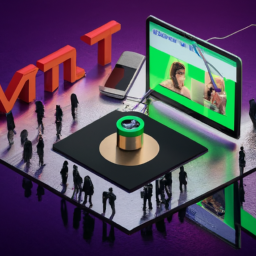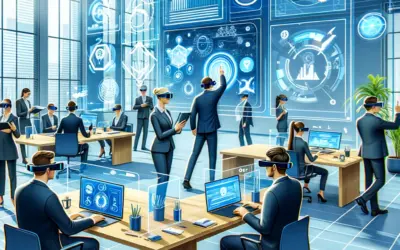As the digital landscape evolves, the concept of virtual meetings is taking a significant leap forward with the integration of metaverse environments. Unlike conventional video conferencing, the metaverse opens up a realm of immersive experiences that mirror physical interactions closely. In this article, we’ll explore the fundamental aspects of conducting business meetings in the metaverse, including the technology that powers these encounters and best practices for engagement.
What is the Metaverse and Its Role in Business Communication?
The metaverse is essentially a collective virtual space, created by the convergence of virtually enhanced physical and digital reality. It is persistently online and active, allowing people to interact in real-time within three-dimensional spaces. For business communication, the metaverse presents an opportunity for more engaging and interactive meetings. Teams can collaborate, share presentations, and network in ways that replicate the nuances of in-person interactions but with the added benefits of virtual reality, such as the ability to record sessions, access instant data, and utilize AI assistants.
Technologies Required for Virtual Business Meetings in the Metaverse
Engaging in the metaverse requires more than just a webcam and microphone. Here are some of the core technologies and tools needed for virtual business meetings:
- Virtual Reality (VR) Headsets: Wearable devices that provide visual and auditory immersion into the virtual environment.
- Augmented Reality (AR) Tools: AR enhances the real world with digital overlays that can be interacted with during a meeting.
- 3D Environments: Customizable spaces that simulate conference rooms, auditoriums, or casual networking lounges.
- Avatars: Personalized digital representations of users that allow for non-verbal communication cues like gestures.
- Collaboration Software: Applications that facilitate teamwork, content sharing, and project management within the metaverse.
As technologies like 5G, cloud computing, and AI continue to advance, the ease and functionality of metaverse business meetings will correspondingly grow.
Best Practices for Conducting Business Meetings in the Metaverse
Adapting to a new meeting environment can be challenging. To ensure successful business meetings in the metaverse, consider following these best practices:
- Set Clear Objectives: Define the purpose and goals of the meeting to maintain focus and effectiveness.
- Prepare the Virtual Environment: Customize your meeting space to suit the agenda and provide any necessary resources in advance.
- Establish Etiquette Rules: Develop a code of conduct for avatar interactions to prevent misunderstandings and promote professionalism.
- Engage Participants: Utilize interactive tools like polls, Q&A sessions, and breakout rooms to keep attendees involved and attentive.
- Test Tech Beforehand: Ensure all participants are comfortable with the technology and that all systems are functioning correctly to avoid delays.
In conclusion, virtual business meetings in the metaverse present an exciting frontier for collaboration and connection. With the right technology and practices in place, they have the potential to transform how we conduct business across distances, fostering a new era of virtual interaction that closely mirrors our natural social behaviors.
Benefits of Conducting Business Meetings in the Metaverse Environment
Enhanced Creative Collaboration
The Metaverse revolutionizes collaboration, making it an immersive experience. Utilizing 3D spaces, teams can interact with digital objects and environments, sparking creativity beyond the limitations of physical rooms. Brainstorming in the Metaverse allows for real-time changes to virtual models, fostering a dynamic and engaging exchange of ideas. By embodying avatars, team members can express themselves more freely, which encourages diverse perspectives to flourish. This virtual interaction also bridges geographical divides, assembling the brightest minds without the need for travel.
Interactive and Engaging Workshops
Workshops in the Metaverse can be tailored with interactive tools that increase engagement. Unlike traditional video calls, participants can manipulate virtual objects or conduct simulated scenarios, making training sessions more effective and memorable.
Diversity in Brainstorming Avatars
Avatars in the Metaverse enable individuals to step outside their usual personas, often leading to the generation of ideas that might not surface in a conventional meeting setup. This avatar-based anonymity can reduce bias and promote equality in idea-sharing.
Cost-Effective and Eco-Friendly Solutions
Conducting meetings in the Metaverse can lead to significant cost savings for businesses. Travel-related expenses such as flights, accommodations, and venue rentals are virtually eliminated. Additionally, this digital approach is environmentally friendly, cutting down on the carbon footprint associated with business travel. The use of virtual environments also simplifies logistics, as there is no need to worry about physical space limitations or booking issues.
Savings on Travel and Accommodations
Virtual environments allow for immediate connection from any location, meaning no time lost in transit and no drain on financial resources for travel arrangements.
Reduced Environmental Impact
By minimizing the need for travel, companies not only save costs but also contribute to reducing greenhouse gas emissions. This positions them as socially responsible organizations which can enhance their brand image in the eyes of eco-conscious consumers and stakeholders.
Scalability and Flexibility of Virtual Spaces
The infrastructure of the Metaverse is inherently scalable and flexible. Businesses can create customizable meeting rooms or event spaces that can expand or contract to meet the needs of the audience. Unlike physical venues, where capacity is a constant hurdle, the Metaverse enables limitless scalability, with the same high-quality experience for all participants regardless of the number of attendees. This adaptability extends to the scheduling of meetings as well, allowing for effortless rescheduling and timezone accommodations without logistical nightmares.
Customization of Virtual Environments
Companies can design their virtual spaces to fit the agenda of the meeting. Tailored environments are more conducive to achieving specific objectives, whether it’s a cozy room for team huddles or an expansive auditorium for large-scale conferences.
Adaptable Scheduling Across Time Zones
The non-physical nature of the Metaverse sidesteps the complications of international time differences. Teams can now find suitable meeting times without the constraints that typically come with coordinating across borders.
Robust Data Analytics and Feedback
Every interaction within the Metaverse can be tracked and analyzed, giving businesses unprecedented access to meeting analytics. This data provides valuable insights into engagement levels, participation patterns, and the effectiveness of different meeting elements. With this real-time feedback, companies can continuously improve the meeting experience. Detailed analytics also allow businesses to make data-driven decisions post-meeting, ensuring that all future encounters are optimized for success.
Real-Time Interactions and Participation Measurement
The tracking of virtual interactions helps facilitators gauge which segments or topics captured the most attention, fostering a more interactive and successful meeting atmosphere.
Post-Meeting Analysis for Continuous Improvement
Through the review of meeting analytics, businesses have the opportunity to fine-tune their strategies, ensuring that each meeting is more effective than the last. By understanding which areas garnered positive responses and which did not, organizations can tailor future rendezvous for maximum impact.
Essential Tools and Technologies for Effective Metaverse Meetings
The emergence of the metaverse has revolutionized the way we think about virtual meetings and collaborations. With the vast potential of these immersive digital spaces, it’s imperative to have the right set of tools and technologies to facilitate effective and engaging meetings. In this post, we’ll explore the foundational components that make up the backbone of effective metaverse meetings.
Immersive Hardware: Gateways to the Metaverse
Virtual Reality (VR) Headsets: VR headsets, such as the Oculus Rift, HTC Vive, and Sony PlayStation VR, provide the primary sensory experience for metaverse interactions. They enable participants to dive into 3D environments and interact in ways that mimic real-world engagement, complete with visual and auditory immersion.
Motion Tracking Sensors: Accuracy in translating physical movements into the digital realm is crucial for a seamless experience. Sensors and controllers that capture gestures and body language ensure that meetings carry the nuance of in-person communication, allowing for more natural interactions.
Software Solutions: Building the Metaverse Meeting Rooms
Virtual Environment Platforms: Robust virtual environment platforms such as Spatial, AltspaceVR, and VirBELA create the digital landscapes where meetings can occur. These platforms offer customizable spaces that simulate offices, conference rooms, or any other meeting environment, providing the necessary settings for various types of professional engagements.
Communication Integrations: In the metaverse, voice and text chat functions must be seamless. Integrating reliable communication tools that provide clear, lag-free conversation is key to maintaining the flow of discussions and ensuring effective collaboration among participants.
Network and Security: The Backbone of Metaverse Connectivity
High-Speed Internet Connection: A stable and fast internet connection is non-negotiable. The bandwidth requirements for transmitting complex 3D graphics and data in real-time make high-speed internet a must-have for any metaverse meeting participant.
Data Security and Privacy Protocols: As with any digital platform, the metaverse is not immune to security risks. Implementing robust encryption and privacy measures is essential to protect sensitive company information and the privacy of meeting participants.
Ensuring that these tools and technologies are in place will pave the way for successful and productive meetings in the metaverse. Given the rapid evolution of virtual spaces, staying abreast of the latest advancements is critical for businesses aiming to leverage the full power of the metaverse for their operational needs.
Best Practices for Organizing and Participating in Metaverse Business Meetings
Preparing the Virtual Environment for Productivity
When organizing a virtual meeting in the metaverse, the digital landscape sets the stage for engagement and productivity. Begin by choosing a platform that aligns with your business needs, ensuring it can facilitate interaction and collaboration. Opt for an environment that is not overly complex, as simplicity helps in maintaining focus. Before the meeting, provide a guide or walkthrough for participants to familiarize themselves with the virtual space. This can help minimize technical disruptions and ensure that everyone is comfortable navigating the meeting.
Essential Tools and Features
To run an effective metaverse meeting, equip the virtual environment with tools that enhance presentation and communication. Seek out features like screen sharing, spatial audio, and interactive whiteboards. These tools encourage active participation and make it easier to convey complex ideas. Ensuring that the metaverse space supports various media formats can also enhance the presentation experience.
Personalizing Avatars and Setting Conduct Guidelines
Encourage participants to personalize their avatars appropriately for the business context. This promotes a professional atmosphere and helps in making virtual interactions more engaging. Additionally, establish clear guidelines for conduct in the virtual space to maintain decorum. Rules should cover aspects such as attire, virtual gestures, and language etiquettes. A well-understood code of conduct can create an environment conducive to productive discussions.
Facilitating Effective Communication During Metaverse Meetings
Clear communication is paramount in any business meeting, more so in a metaverse environment where physical cues are absent. Use clear and concise language to articulate points, and encourage participants to be brief yet thorough when sharing their ideas. Always provide an agenda before the meeting, detailing the topics for discussion. This keeps the meeting structured and ensures every participant is prepared to contribute. To facilitate better understanding, periodically summarize key points and confirm that all members are on the same page.
Promoting Engagement and Interaction
Virtual meetings can sometimes feel impersonal, so it’s crucial to foster interaction. Use interactive tools like polls, quizzes, and breakout rooms to keep participants engaged. Encourage everyone to turn on their microphones and cameras if appropriate, as this can offer a more immersive and personal communication experience. Consider assigning roles or activities to different members to maintain active involvement from all attendees.
Managing Technical Issues
Technical glitches can derail a metaverse meeting, so prepare in advance to mitigate any issues that may arise. Designate a technical support person who can assist participants with any difficulties. It’s also advisable to have a contingency plan, like a secondary communication channel, in case the primary platform encounters problems. By anticipating technical challenges, you can ensure they don’t interrupt the flow and productivity of your meeting.
Post-Meeting Follow-ups and Feedback
Concluding a meeting effectively is as important as starting one. Wrap up by summarizing decisions and assigning actionable tasks with clear deadlines. Post-meeting, send out minutes or a recording of the session to all participants for reference. This helps solidify the discussion points and ensures accountability. Additionally, seek feedback on the meeting experience to identify areas for improvement. Providing a short, anonymous survey can prompt honest reviews and help optimize future metaverse meetings.
Acting on Feedback for Continuous Improvement
Collecting feedback is fruitless without acting on it. Analyze the responses to identify common issues or suggestions. Implement changes to the virtual meeting protocols or environment as necessary to improve the overall experience and effectiveness of your metaverse business meetings. By continuously refining your approach based on participant feedback, you establish a culture of improvement and innovation within your organization.
Future Trends: The Evolution of Business Meetings Within the Metaverse
The Rise of Virtual Meeting Spaces
The transformation from physical to virtual meetings had been notably accelerated by global events such as the COVID-19 pandemic. As businesses adapted to remote work, the effectiveness and efficiency of virtual meetings came into sharp focus. Now, with the metaverse, we’re seeing a transition toward 3D virtual environments that replicate the dynamics of in-person interaction and provide an enriched communication medium for attendees, irrespective of their physical location.
Incorporating Advanced Technologies
Businesses are exploring how the metaverse can leverage cutting-edge technologies to facilitate meetings. Facets such as virtual reality, augmented reality (AR), and mixed reality (MR) tools are becoming integral to the metaverse meeting experience. Participants can don VR headsets to enter a immersive virtual environment or use AR glasses to project digital information onto their physical surroundings, enhancing their meeting experience with rich, interactive content.
Immersive Interactions and Personalized Avatars
Immersion is a key feature of metaverse meetings, with personalized avatars offering a new layer of interaction. These digital representations enable participants to engage in the metaverse authentically, incorporating gestures, expressions, and even their own distinctive characteristics. Unlike video calls, where body language can be hard to read, the metaverse can simulate a more natural meeting environment where such cues are captured and conveyed effectively.
Integrating Artificial Intelligence
Artificial Intelligence (AI) promises to play a significant role in optimizing metaverse meetings. AI can streamline meeting schedules, curate content relevant to the discussion, and even facilitate real-time language translation, making global business interactions more accessible. By automating administrative tasks, such as minute-taking and follow-up scheduling, AI within the metaverse can free participants to focus on the essence of their discussions.
Enhanced Networking and Collaboration
- Virtual Networking Spaces: These spaces allow for spontaneous interactions akin to traditional networking events, extending the value of meetings.
- Dynamic Collaborative Tools: Real-time document editing, shared digital whiteboards, and interactive polls are just a few tools transforming collective work within the metaverse.
Environmental and Cost Implications
A significant benefit of the metaverse lies in its potential to reduce the carbon footprint associated with business travel. Virtual meetings within the metaverse eliminate the need for physical travel, presenting an eco-friendly alternative with a markedly lower environmental impact. Additionally, companies can experience a drastic cut in expenses related to travel, accommodation, and venue hiring, driving a shift in budget allocation toward technological investments that enhance the virtual meeting experience.
Building Sustainable Business Practices
The sustainability angle is increasingly becoming a corporate priority, and metaverse meetings align perfectly with this agenda. By leveraging the metaverse for business interactions, organizations can contribute to sustainability goals, improving their corporate image while benefiting from the efficiency and engagement that these futuristic meetings offer.













0 comentarios